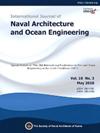A Kolmogorov-Arnold network-based method for predicting underwater explosion shock spectrum considering cabin structural characteristics
IF 3.9
3区 工程技术
Q2 ENGINEERING, MARINE
International Journal of Naval Architecture and Ocean Engineering
Pub Date : 2025-01-01
DOI:10.1016/j.ijnaoe.2025.100671
引用次数: 0
Abstract
This study introduces an innovative approach for the rapid prediction of shock spectrum in ship structures subjected to underwater far-field explosion loads. A nine-compartment ship model is developed, with 31 test condition sets designed. For each set, sample measurement points are strategically placed at typical locations across various deck levels and on the inner and outer bottoms of the double bottom at different frame cross-sections. Shock spectrum (including spectral velocity, acceleration, and displacement) are extracted from these sample points to establish a comprehensive shock spectrum database. Using the Kolmogorov-Arnold Network, a rapid prediction model for ship structure shock spectrum is developed. The network's inputs include ship structural formal parameters (e.g., number and position of decks, transverse and longitudinal bulkheads), impact factors, feature transfer distances, and local shock factors. Spectral velocity, acceleration, and displacement are used as the network's outputs during training. A comparative analysis of prediction accuracy among the Kolmogorov-Arnold Network, Backpropagation Network, and Convolutional Neural Network is conducted. The results demonstrate that the Kolmogorov-Arnold Network exhibits superior predictive accuracy compared to the Backpropagation and Convolutional Neural Networks. In contrast to existing finite element simulation methods, the proposed approach is simpler and more practical. Furthermore, unlike current rapid prediction methods, the proposed method takes into account the influence of ship structural characteristics on underwater explosion shock responses, making it better suited to the requirements for rapid prediction of underwater far-field explosion shock spectrum in ship structures.
基于Kolmogorov-Arnold网络的水下爆炸冲击谱预测方法
本研究提出了一种快速预测水下远场爆炸载荷作用下舰船结构冲击谱的创新方法。建立了九舱船舶模型,设计了31组试验条件。对于每一组,样本测量点被战略性地放置在不同甲板水平的典型位置,以及不同框架截面的双层底部的内外底部。从这些采样点提取激波谱(包括谱速度、加速度和位移),建立一个综合的激波谱数据库。利用Kolmogorov-Arnold网络,建立了船舶结构冲击谱快速预测模型。该网络的输入包括船舶结构形式参数(如甲板的数量和位置、横向和纵向舱壁)、影响因素、特征传递距离和局部冲击因素。频谱速度、加速度和位移在训练过程中被用作网络的输出。对比分析了Kolmogorov-Arnold网络、反向传播网络和卷积神经网络的预测精度。结果表明,与反向传播和卷积神经网络相比,Kolmogorov-Arnold网络具有更高的预测精度。与现有的有限元模拟方法相比,该方法更简单,更实用。此外,与现有快速预测方法不同,该方法考虑了舰船结构特性对水下爆炸冲击响应的影响,更适合舰船结构水下远场爆炸冲击谱快速预测的要求。
本文章由计算机程序翻译,如有差异,请以英文原文为准。
求助全文
约1分钟内获得全文
求助全文
来源期刊

International Journal of Naval Architecture and Ocean Engineering
ENGINEERING, MARINE-
CiteScore
4.90
自引率
4.50%
发文量
62
审稿时长
12 months
期刊介绍:
International Journal of Naval Architecture and Ocean Engineering provides a forum for engineers and scientists from a wide range of disciplines to present and discuss various phenomena in the utilization and preservation of ocean environment. Without being limited by the traditional categorization, it is encouraged to present advanced technology development and scientific research, as long as they are aimed for more and better human engagement with ocean environment. Topics include, but not limited to: marine hydrodynamics; structural mechanics; marine propulsion system; design methodology & practice; production technology; system dynamics & control; marine equipment technology; materials science; underwater acoustics; ocean remote sensing; and information technology related to ship and marine systems; ocean energy systems; marine environmental engineering; maritime safety engineering; polar & arctic engineering; coastal & port engineering; subsea engineering; and specialized watercraft engineering.
 求助内容:
求助内容: 应助结果提醒方式:
应助结果提醒方式:


